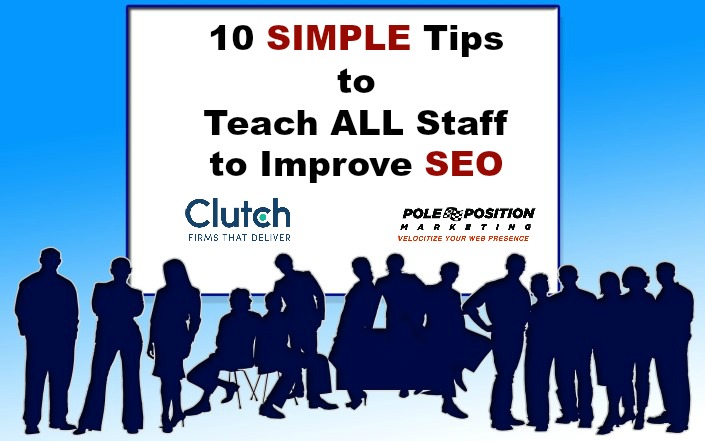It takes a village to build and maintain an online presence these days—with websites remaining the primary central hub for all online activity. Organizations of all stripes work hard to drive traffic to their websites through a combination of direct, organic and referral traffic. Organic is where search engine optimization (or SEO) comes into play. Successful SEO requires a combination of technical (e.g. URL structure) and content-based (e.g. the words and phrases you include in your content) considerations.
Importantly, the responsibility for SEO doesn’t lie solely with your webmaster. [inlinetweet prefix=”” tweeter=”” suffix=””]SEO is really, or should be, the responsibility of anyone who creates content for any part of your website.[/inlinetweet] Your staff can play an important role in ensuring that you’re using the right information, in the right way, to boost results.
What do you—and they—need to know to do this effectively? Stoney deGeyter is CEO of Pole Position Marketing, an SEO firm in Canton, OH; he founded the firm in 1998. He has literally “written the book” on simple SEO—The Best Damn Web Marketing Checklist, Period! The following are some simple tips* that can help you engage your entire staff in ensuring that your website will gain traction through SEO.
- Develop personas that reflect your target audience(s) and make sure everyone who is posting content to your site thoroughly “knows” these people. It’s a great way to ensure that you’re really talking directly to your audience and, while some may initially think personas are silly, you can quell their objections by letting them know that personas are commonly used by the most successful brands.
- Get inside the heads of your personas to think about how they would search for what you have to offer. What words and phrases do you think they would use? This list should serve as the starting point for in-depth keyword research that will reveal the keywords that should be used in your copy.
- Get attention! Each page of your content should serve to capture attention—quickly. You can do this through compelling, keyword-friendly headlines, strong opening sentences and conversational language designed to address key benefits that are important to your audience.
- Answer that critical consumer question of: “What’s in it for me?” You need to quickly and clearly convey to website visitors why what you have to offer is important.
- Get rid of the jargon. Your “insider” terminology may not be familiar—or even understandable—to outsiders. Rather, use the language they will be most familiar with, which should be the terms you uncovered in your keyword research (see point #2).
- Keep it clean and simple. Don’t create too much “noise” on your website pages or visitors will simply give up and look elsewhere for the information they need. Eliminating unnecessary content is important; don’t fall in love with your copy—keep it short and simple (KISS).
- Keep your content error-free! Typos, spelling and grammar errors reflect extremely poorly on your brand. It’s a great best practice to ensure that all content created for your website is reviewed by at least one other person.
- Underline clickable links so visitors notice them! In the early era of websites, links were blue and underlined; today, though, that’s not always the case. But many visitors are still used to this visual clue. Why make it difficult for them by displaying clickable links in other formats?
- Think mobile! Many people are accessing content via mobile devices these days, which delivers an entirely different experience than desktop or even laptop and tablet devices. Because of this, it pays to “think small” when creating content. Chuck your content into easily digestible blocks of copy to avoid long pages that require too much scrolling.
- Link to contact information. If you want potential customers to be able to get in touch with you—and who doesn’t?—make sure that contact information is displayed prominently, and frequently, on your web site. That doesn’t just mean phone numbers! Each customer has a preferred way of reaching companies, so you want to be sure they are able to contact you in the way that makes them most comfortable. Specifically, brick and mortar establishments should include an address that’s tied to GPS coordinates; and always, always include a means of connecting online via email or a fill-in-the-blanks form.
These are just 10 simple tips that can help you help your staff to ensure that prospects will not only find your website online but, once they do, that they will be engaged with your content and more likely to take some desired action.
If you found these tips helpful, there are hundreds (literally) more in The Best Damn Web Marketing Checklist, Period!
*And we mean simple! Some of these may seem like “duh!” solutions but, trust us, far too many websites don’t take these points into consideration. Their loss!

Author Bio: Tim Clarke is the Research Manager with Clutch, Clutch identifies leading software and professional services firms that deliver results for their clients. Tim heads the SEO and PPC research at Clutch. You can follow Clutch at @clutch_co

